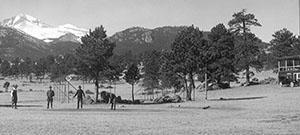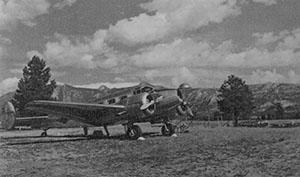The Estes Park 18-Hole Golf Course is over 100 years old!
History of the Estes Park 18-Hole Golf Course
Most historians point to Scotland as the likely birthplace of the modern game of golf, and since its inception in the Middle Ages, the game has been played in a variety of forms.
The game started gaining international popularity in the late 19th century, and it was around this same time that Windham Thomas Wyndham-Quinn, the Fourth Earl of Dunraven, visited Estes Park for the first time. He arrived in Estes Valley in late 1872 on a hunting expedition after hearing of the sportsman's paradise in this mountain valley. Falling in love with the area, he returned in 1873 and 1874 and started purchasing - and some reports say swindling - his way into the ownership of Estes Park. The next year, in 1875, Lord Dunraven built a rudimentary golf course of some sort, but little is known of its style or size.
In 1877, Lord Dunraven and his friend, Albert Bierstadt, selected a site and built the Estes Park Hotel, a popular English-style retreat. He also built a small cottage that year on the east side of Fish Creek that is still in use today.
But Lord Dunraven eventually started to lose interest in Estes Park, possibly because of the increasing number of tourists - sometimes as many as 200 in one summer. (A vast difference to the more than 4.5 million people that traveled into Rocky Mountain National Park in 2016.) His last visit to the area was in the mid-1880s, and in 1906 he sold his 6,000 acres of Estes Park property to The Estes Park Investment Company.

That group of investors is responsible for opening what is today the Estes Park 18-Hole Golf Course. They started by building a clubhouse, which was completed in 1909 and is today where Smokin' Dave's BBQ at the Hangar and the pro-shop are located. The building was modeled after Lord Dunraven's cottage across Fish Creek.
On November 10, 1917, The Estes Park Golf and Country Club filed articles of incorporation. Some of Estes Park’s most notable men of the time served on the Board of Directors—H.P. James, H.E. James, E.J. Mills, Ed B. Andrews, J. E. McDonald, Samuel Service and Julian Hayden. Over the next few months, by-laws were written, 250 stock shares were issued with a value of $25,000, and three members—Howard James, Homer James and Ed Andrews—were appointed to build the course.

The first design was an 18-hole course set against Fish Creek, where a former course financed by Lord Dunraven once stood and a clubhouse used by that course was built in 1909. H.E. James was appointed the first golf operator.
The three men worked hard through the winter and spring, and the course opened for the first round of play on July 4, 1918.
Due to the financial crisis happening in the U.S. in the 1930s, the 18-hole course was converted to a 9-hole course and an airstrip was built on the western edge of the course with hopes to improve sagging tourism in the area. The airport did very little to promote travel to Estes Park and was a dangerous location that resulted in several bad crashes. It closed in the late 1940s.
As finances at the golf course continued to stumble along, the decision was made to sell the leasing rights of the Estes Park Country Club to the Town of Estes Park. Since the value of this stock was so low, the country club stockholders, after a two-thirds majority vote on July 6, 1944, turned over their stock to the Town of Estes Park. By the mid-1950s, the Town of Estes Park was in full ownership of Lord Dunraven's golf legacy.
In March 1957, the Town of Estes Park signed a long-term lease agreement with the recreation district, then called the Rocky Mountain Metropolitan Recreation District.
The recreation district soon thereafter started the process of obtaining funding to transform the 9-hole course from one with buffalo grass fairways, sand greens and prairie for rough back into an 18-hole course with grass fairways, a watering system and locker rooms with showers. Henry Hughes, a golf course architect from Denver who designed and built more than 40 golf courses in Colorado, Wyoming, Utah, Nebraska and Texas during his career, was hired to transform the Estes Park Golf and Country Club.
The remodeled course opened on July 5, 1960 as the Estes Park Municipal Golf Course, which has evolved into being called the Estes Park 18-Hole Golf Course.
In 2018, the Estes Park 18-Hole Golf Course will celebrate 100 years of operation in Estes Valley. Several upgrades have been made over the years, including the addition of an irrigation system in the 1970s and a new fleet of gas-powered golf carts for the 2017 golf season. The management of the course is now overseen by Estes Valley Recreation and Park District, but the property continues to be owned by the Town of Estes Park.
